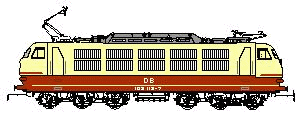
PICTURES OF MÄRKLIN LOKS ON MY LAYOUT

PICTURES OF MÄRKLIN LOKS ON MY LAYOUT
Click on any small picture to see large pictures of the engine. Click on any large picture to return to this screen.
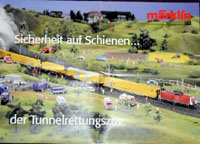
P
ictures of the Marklin (26510) rescue train set (Tunnelrettungszug zugpackung). This DB train is used to fight tunnel fires and for rescues in a tunnel. It consists of two Class 714 diesel loks and five specialized cars - a transport cars at each end next to each lok (transportenwagen), one equipment car (gerätenwagen), one fire extinguisher car (löschmittelwagen) and one first aid car (sanit"a"tswagen). The train has a Class 714 at each end. The train is pushed into the tunnel with its own air supply system. When the train and its crew reach the site of the fire they place persons needing first aid in the the transport car closest to tunnel opening. The lok and this car is detached from the rest of the train and pulled out to the rear staging area. On the Marklin set there is a Telex coupler on this transport car which allows it to be uncoupled from the rest of the consist.This set has one powered lock which pushes the consist into the tunnel and an unpowered lok. The consist has three decoders. One in each of the loks and one in the transport car with Telex. The powered lok and the transport car decoders are set at the same number (33 factory) and the decoder in the unpowered lok is a different number (34). The functions control emergency blinking lights are each lok, an emergency blinking light at end of the transport car with the Telex, and side lights on both transport car. The cars on this set are connected with current-conducting couplers except on the first transport car which has a Telex coupler. This is a really nice set.

P
ictures of the ten car Union Pacific boxcar set (Marklin 45646). These are U.P. Type B-50-24/B-50-27 boxcars. Each car is different and has a unique road number. The Union Pacific Big Boy pulls the consist of boxcars on the layout. Marklin will produce a UP hopper car set and a UP caboose. Trix will also produce additional Union Pacific boxcars. I have ordered them and when they arrive I will add them to the consist.Also see pictures below of the UP Big Boy pulling a long (18 cars) consist. The cars, however, are not typical of the Big Boy era in American railroading. Now I have to find an American lok that is consistent with these cars.
Pictures of the Tragschnabelwagen (the Schnabel transformer transport wagon) (Trix 23994) pulled by a DB V288 Diesel Electric (Märklin 37284). This is an Era IV wagon. The actual prototype was purchased in 1973 by the German Federal Railways (DB). It consisted of two Uai 839 cars capable of suspending a very large, heavy transformer between them. It measured 63.28 meters or 207 feet. It was the largest freight car(s) in Europe. It had 32 axles. For comparison purposes, the torpedo car has 18 axles.
In actual use, many catenary masts and signal masts had to be taken down and bridges had to be raised in order to allow the car(s) to pass. On dual tracks only this train was allowed to run for fear it would hit trains on the other track as it rounded curves. The load can be sifted by hydraulics, right or left, to allow for passage in tight spots.
The car(s) is(are) the largest on my layout. I thought the torpedo car was long. This dwarfs the torpedo car. It is 720 mm or 28 3/8 inches over buffers. It extends quite a bit over the track bed especially as it rounds curves. A tip to all who are building a layout with catenary and signal masts, all signal masts and catenary masts must be on the outside of the curve to allow this monster to pass. You have to see the pictures of this behemoth on my layout to appreciate how much of an overhang there is. Unfortunately, if you have the Big Boy you must have the catenary and signal masts on the inside to allow for the overhand of the front boogie.
The DB V288 Diesel Electric (Märklin 37284) is a powerful lok that probably would have just been going out of service when the tragschnabelwagen was first put in service. It was originally a V 188 but after retrofitting it left DB service as the V 288. This lok has nice sound and great performance. As the pictures show, it was able to push the tragschnabelwagen up a 4% grade with no problem. Nice as the tragschnabelwagen is, it will not see a great deal of running time on my layout. There are just so many large transformers to be delivered and I currently have all that I need right now.
The transformer can be removed and the two Uai 839's can be connected. Sounds simple but it took me 30 minutes to remove the transformer and connect the two Uai 839's. There are small parts that kept falling out of there slots. The process is not one I want to do again. I think the transformer stays where it was dropped off on the layout. Without the transformer the two connected Uai 839's do not extend as much and can run on more of my layout.
Surprisingly, though it can only run in a limited part of the layout, it has run well, even on my M track layout. I did not retrofit the wheel sets with Märklin wheels. It is running on the Trix wheels.
P
ictures of Märklin's Union Pacific 4-8-8-4 locomotive. This locomotive is an Insider engine. It has two chips with numbers 40 and 41. The first chip controls the engine's speed, a smoke unit, if installed, the lights, the sign boards and acceleration control. The second chip is the sound chip which contols the chuffing sound, the whistle and the bell.This loco has great detail. Even though it is articulated, it does extend over the road bed on turns. I am running it on M track which Märklin states is not the best track on which to run it. Marklin recommends C and K track as the most dependable for the Big Boy. Despite that warning my BB runs fine on my M track layout. I just watch the older turnouts.
The Big Boy is pulling a consist of 18 American freight cars with a Milwaukee Road caboose. There are pictures of these cars as well. Its hard to explain what it is doing on a Germany layout so I keep it on a shadow station siding and run it when I want to admire this beauty.
Truly an engine worth having.
The Big Boy has a rich history in the annals of American railroading. The UP Big Boys was built to haul freight from Odgen to Watash over a 1.14% grade. Twenty-five were built and the first, engine number 4000, a "class 1" was delivered to Ogden, Utah in September 1941. The Big Boys were taken out of service in 1959 and most were out of service by 1961. The last was retired from service in Utah in 1962 but in 1962 there were still four Big Boys operating in Green River, Wyoming.
By the way, the Big Boy is frequently referred to as a Mallet locomotive. It is not since it has a simple expansion rather than compound expansion which Mallets had. .
The sharpest curve the Big Boys could negotiate was a 20 degree curve. In HO scale, this would be a 40 inch radius curve.
Some of its history though is myth. One example - the Big Boy is NOT the largest engine ever built. To see which engine(s) are larger and a complete history and a full description of its specifications go to the URL below:
Click here to see more about the Big Boy.P
ictures of six of my eight ICE triebwagens. The pictures are of the DB ICE 3, the NS ICE 3, the DB ICE sine, the DB double ICE 2, the DB ICE 2, the DB Elisabeth ICE. Not shown are my ICE 1 and the Amtrak ICE which are both in storage.P
ictures of the Bavarian State Railroad Gt 2 4/4 (BR 96) tank lok with a consist of freight cars.P
ictures of Märklin (37080) Insider BR 10 steam lok. This is one of the best loks that Märklin has produced. It has a great whistle sound and a really good chuffing sound which is syncronized to the rotation of the wheels. You can set the chuffing sound to 3 chuffs per wheel rotation or 6 chuffs. I prefer the 3 chuff mode. The decoder is in the tender making it easy to set the accelereation/deceleration speeds and the lok decoder number. I am waiting for the Seuthe smoke unit which will really make the lok look great. The sound, detailing and running characteristics make this one of my favorite loks. I like this dampflok so much that I have purchased a second one.Click on the image above to see pictures of the BR 10.
To appreciate the sound I have created a short MPEG video file which runs with Real video viewer. It may take a while to load the file but when it runs you will see and hear the chuffing sound synchonized with the engine speed.
Click here to see and hear
the BR 10.
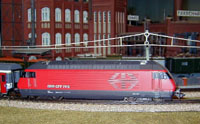
P
ictures of the SBB CFF FFS 2000 Class 460 electric lok (Märklin 3760) and a consist of passenger coaches. The coaches are from a special set (Märklin 4367, issued in 1994) of six cars including one 1st class coach, two 1st observation cars, a "Le Buffet" car" and two 2nd class coaches. I have added a special salon car (Märklin 42157) which was used when the Pope visited Switzerland. Recently Märklin issued a control cab (42178) which I have added to the set. I have pictures of each coach as well as several pictures of the lok. I intend to change loks for this consist by using one of the many 460's with advertising on them such as the Tilster Cheese engine. I have several HAG 460 with special livery as well which I will also use.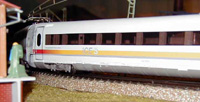
P
ictures of Märklin (39710) ICE Sine engine set as it travels over my layout. This engine has a special sine motor. The engine set was available to a select group chosen by lottery. The winners were asked to test and evaluate the engine. I ran the engine as requested and found that it performed flawlessly. It climbed a 5% grade with no problem at a speed of 8. I stopped it on the incline and restarted it at a speed of 2 with no problem. The engine started on a level surface at a speed of 2 as well. The engine rolls to a smooth stop within ten centimeters. Acceleration and deceleration was very acceptable.P
ictures of two Märklin Class 151 electric loks, Märklin 37432. These engines have two sounds, a great whistle and the sound of squealing brakes. One of the loks is powered, the other is unpowered. The consist is made up of Märklin and Roco cars. There are two Cargo info cars behind the tandem 151's. The engines are seen pulling ten cars with no problem. A great looking consist.P
ictures of the Märklin Class 110 (E10) Express Lok, Märklin 3039. This lok and the Class 140 or E40 look the same except for color. The E 10 is blue and the E 40 is green. They are very different inside. The E 10 was put into service in 1956 as a passenger express lok with a top speed of 90 mph while the E 40 was put into service as a freight lok with a top speed of 60 mph. Both had a tractive force of 5,000 horsepower but had different transmissions. In case you are wondering this engine was advertised in the 1970 Märklin catalog for $26.95.P
ictures of the Märklin Goliath Crane. The largest German railroad crane is called "Goliath" and was built in 1977 by Krupp. It has been stationed in Dortmund, Hannover and Würzburg, constructing bridges, rerailing locomotives and cars, and handling heavy loads. It can lift 150 metric tons within a working radius of up to 8 meters (approx. 26 feet) and can lift 32 metric tons with a radius of 18.5 meters (approx. 61 feet).
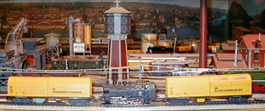
P
ictures of the LUX 9020 "rail grinding wagon", the Schienenschleifwagen, rail cleaner and the LUX 8820 vacuum cleaner, Gleisstaubsauger. These are pushed and pulled by a BR 81, (Märklin 3031). Both the cleaning car and the vacuum car are digitalized with a 6080 decoder. Actually there is no need to digitalize either unit but it is convenient if you use a computer program (i.e., TPL) as I do to control the cleaning of the tracks. The digital function allows me to turn the cars on and off at various points on its route. The Cleaning Car is turned on and off using the function control as you would turn head lamps on and off. The Vacuum Car is control by the speed setting.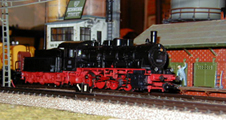
P
ictures of the Märklin (37550) BR 55 (Prussian G8.1) freight "dampflokomotiven". This is a unique coreless-motor engine. As such it is virtually maintenance free. It has great pulling power and runs smoothly. It is seen hauling a consist of ten Shell tank cars. Scenes of the refinery and other sections of the layout can be seen in these photos.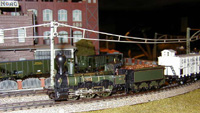
P
ictures of the Märklin (37971) Bavarian Royal State Railways (Königlich Bayerische Staatsbahn, K.Bay.Sts.B.) B VI lok and Märklin (43982) passenger car set. The B VI loks were first manufactured in 1863 and were so successful that 107 engines with variations were built until 1871. These trains ran from Munich to Rosenheim, Simbach, Weilheim, Murnau, Tölz and Schliersee. This engine bears the name Tölz. This train includes a perishable goods car, three passenger coaches and a trailing baggage car. The restroom was located in the baggage car. The B VI was a peat burning engine; note the brown peat in the tender. Peat-fired loks were used in Southern Bavaria while coal was used in the North. These loks had characteristic pear-shaped or ballon-shaped smoke stacks. Note the difference in this engine compared to the B VI lok used with the Peat Transport Train in the link to the group of pictures of the "Peat Train" below.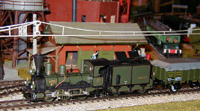
P
ictures of the Märklin (3797) Bavarian Royal State Railways (Königlich Bayerische Staatsbahn, K.Bay.Sts.B.) B VI lok pulling the Märklin (4897) "Peat Train". This lok was part of the group of B VI's build between 1863 and 1871. They were used for passenger and freight service. One of these engines, with variation, was used for the King Ludwig train. Note the characteristic pear-shaped smoke stack. The detail on this engine is excellent. It is named Murnau for one of the villages serviced by this train. Note the closed tender. These loks were peat-fired. The efficiency of peat as a fuel was affected by moisture so this lok has a closed tender with hoods that can be seen open in the pictures. Also note the peat filled car has a cover. The crane was used for loading the peat. Peat was available in Southern Bavaria while coal was available in the North. A very nice lok and consist.P
ictures of the Märklin (37060) Bavarian Royal State Railways (Königlich Bayerische Staatsbahn, K.Bay.Sts.B.) EP 3/6. Four of these loks were purchased by the K.Bay.Sts.B. as passenger loks. I have assembled a consist of passenger coaches two CCü 3rd Class coaches (Märklin 41351), one ABCCü 1st-2nd-3rd Classes coach (Märklin 41361) and one PPü baggage car Märklin 41371). The EP 3/6 was an AC powered lok but it had a steam boiler to provide heat for the passenger coaches hence the stack in the front and the two pantographs in the rear. The DRG designated these four loks as E 36 - three driving axles with six total axles.P
ictures of the Märklin (37090)P
ictures of the Märklin (49960) Meßwagen. This measurement car is digitally controlled and allows prototypical measurement of speeds, lapsed times and running times. It is seen here being pushed by a DB Class 212 diesel but it is used with all engines to determine there prototypical speeds.P
ictures of the Märklin BR 52 engine. This engine is a powerful engine used to haul freight consists. It is pictured here crossing the trestle bridge with a full head of steam. It is on its way to pick up a consist of lumber cars. This engine came with the snowblower but I switched the condenser engine to pull the snowblower and use this for freight consists.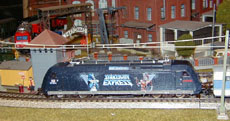
P
ictures of the Starlight Express, Class 101 engine, pulling a Talgo Company InterCity Night train. What better engine than the Starlight Express to pull an overnight train. There are several scenes of the engine on the layout. As the train passes it, look for the lumber yard section of the layout.
P
ictures of the Insider Pneumatic Diesel engine (Märklin 3720). There are two V32's seen in these pictures. The engines were pneumatic engines that used heated air. These engines, first used in 1929, were in use around Stuttgart for several years. The cost effectiveness of these engines was no better than steam loks and their use was discontinued.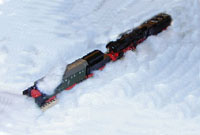
P
ictures of the Insider Rotary Snow Plow (Märklin 26830) being pushed by Condenser steam lok (Märklin 37171). This is a fantastic combination suggested by Ricky on the MML. The snow plow has rotating blades, a set of working lights and a single head lamp, doors and a chute that can be manually set for throwing the snow right or left and it has realistic sound. Suethe #11 smoke units can be added to both the snow plow and the lok for more realism. Märklin did a great job on this one. There are pictures of the Snow Plow moving through snow drifts.
P
ictures of the Insider Rotary Snow Plow which is pushed by a Br 52 steam lok (Märklin 26830). This is a fantastic working set. The Snow Plow has rotating blades, a set of working lights and a single head lamp, doors and a chute that can be manually set for throwing the snow right or left and it has realistic sound. Suethe #11 smoke units can be added to both the plow and the lok for more realism. Märklin did a great job on this one.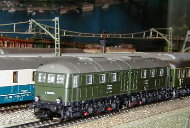
P
ictures of the V188 double diesel (Märklin 37282) pulling a consist of passenger cars. There are several pictures of the V188 lok passing through the farm section of my layout. This is a great engine with diesel engine sounds and a horn sound.
S
everal pictures of a Royal Bavarian State Railways (K.Bay.Sts.B.) S 3/6 steam lok (Märklin 37185) pulling Württemberg passenger cars. The S 3/6, with its beautiful detail, is one of the most frequently collected engines.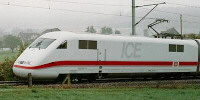
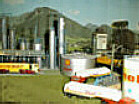
Several views of the Shell refinery and one picture of the Esso refinery. A DB Class 212 hydraulic diesel engine (Märklin 3147) is ready to pull a consist of Shell tank cars, some two axle and others four axle. I like to put consists together which have cars that match. The buildings are primarily Vollmer models with some Kibri.

S
everal views of the Swiss Federal Railways (SBB) Ae8/14 double engine (Märklin 37591) as it moves on the mainline and as it approaches a freight station. The engine is pulling a long consist of 15 Von Haus/Zu Haus container cars. This is a very powerful engine well worth having on any layout.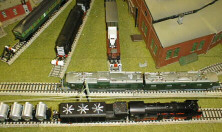
T
he Insider Condenser DB 52 engine (Märklin 37171) with turning fans. I have added a Seuthe smoke unit to the engine. The fans are turned on with the F1 function and the smoke with the F2 function. Two of the scenes show a top view of the condenser engine with one view of the SBB Ae 8/14 engine. The other two scenes show the engine hauling a consist of Von Haus/Zu Haus container cars.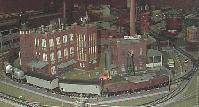
T
his a a factory scene with a consist, pulled by a (Märklin 3652) Swiss Crocodile, waiting on a siding to be loaded. The roundhouse and turntable are just behind the factory.
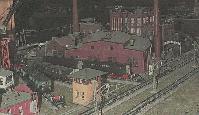
T
his is a view of the back of side of the roundhouse and the three sidings that are adjacent to it. The sidings connect to the turntable. The (Märklin 3426) Belgian VT 651 railcar runs a route that brings the turntable to its siding; it enters the turntable; the turntable returns to the main line, the railcar runs a route around the layout returning to the turntable; the railcar is returned to its original place, ready for its next run. The factory is in the background.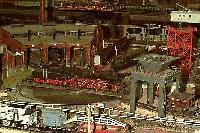
T
his view shows the roundhouse and the turntable with a (Märklin 3084) Class 050 2-10-0 decapod in the process of being routed to the mainline. Two (Märklin 3720) pneumatics are on the siding adjacent to the roundhouse. An electric freight-car engine is next to it and a (Märklin 3426) Belgian VT 651 railcar is on the third siding. A coaling station and crane are a part of the scene.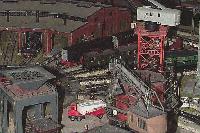
A
gas tank and coaling station make up part of this scene in the industrial part of the layout. Two (Märklin 3720) pneumatics can be seen next to the roundhouse. Two cranes, one used for engine repair and the other as part of the coaling station, partially obscure the (Märklin 3683) freight-car engine and the (Märklin 3426) Belgian railcar.
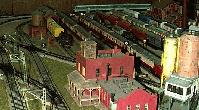
A
yard, with two (Märklin 3071) Dutch/Swiss RAm/TEE 1 (Trans Europ Express) trains (the Edelweiß), is flanked by several industrial structures
including a cement tower and a warehouse. In the far background is a (Märklin 3776)
double railcar that tilts as it rounds a curve. It's a fantastic sight to see. In the
siding to the left of the two TEE's is a consist including a (Lux 8820) vacuum car and a
(Lux 9020) track cleaning car, both digitally operated. These are pulled by a (Märklin
3031) tank engine.
trains (the Edelweiß), is flanked by several industrial structures
including a cement tower and a warehouse. In the far background is a (Märklin 3776)
double railcar that tilts as it rounds a curve. It's a fantastic sight to see. In the
siding to the left of the two TEE's is a consist including a (Lux 8820) vacuum car and a
(Lux 9020) track cleaning car, both digitally operated. These are pulled by a (Märklin
3031) tank engine.

T
his is a view of one of the sidings with a (Märklin 3655) S-Bahn commuter train on one of the sidings. It is pulled/pushed by a (Märklin 3655) DB class 111 electric engine. These commuters are used in the Rhine-Ruhr region. In the lower left is the (Märklin 3750) Elizabeth ICE train. In the background is a consist of VTG tank cars being pulled by a (HAG 240) BLS Ae 8/8.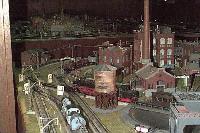
T
his view shows the industrial section in the foreground and the city section in the background. A (Märklin 83307 Museum 1994)tank engine with a work train is waiting on the siding. The water tank and turntable is seen with a (Märklin 3084) Class 050 2-10-0 decapod moving on to the main line. In the second picture, an SBB Ae 8/14 is seen pulling a consist.
![]()
T
he work train pictured here is on a siding waiting to enter the main line to do repairs down track. It is pulled by a (Märklin 83307 Museum 1994)tank engine. It consists of two (Märklin 4611) crane cars with trailing flat cars, a ballast hopper car and a flat car with ties.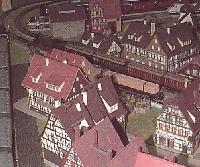
![]() Revised:
Revised:
A
view of the village section with two passenger trains, one pulled by a (Märklin 3609) Prussian steam tank engine and the other by a (Märklin 3412) tank engine. A saw mill with a DB (Märklin 3680) Köf II diesel engine and a consist of lumber cars on a siding adjacent to it is in the center of the picture. The Köf II and the mill itself are hidden from view.
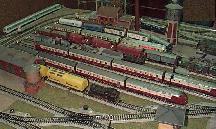
A
n aerial view of the industrial yard section with two (Märklin 3071) Dutch/Swiss RAm/TEE 1 (Trans Europ Express) trains (the Edelweiß), a
Junkers airplane train, a freight consist hauled by a Class 191 E 91 articulated electric
engine, five beer cars in front of the . Aktien Brewery - Wulle Stuttgart. In the upper
left, you can see the (Märklin 3776) double railcar that tilts as it rounds a curve. In
the foreground you see a the LUX digital vacuum car and the LUX digital rail-cleaning car
which is pulled by a (Märklin 3031) tank locomotive with Telex.
trains (the Edelweiß), a
Junkers airplane train, a freight consist hauled by a Class 191 E 91 articulated electric
engine, five beer cars in front of the . Aktien Brewery - Wulle Stuttgart. In the upper
left, you can see the (Märklin 3776) double railcar that tilts as it rounds a curve. In
the foreground you see a the LUX digital vacuum car and the LUX digital rail-cleaning car
which is pulled by a (Märklin 3031) tank locomotive with Telex.

A
view of the Calw Station. Two SBB CFF FFS commuter trains are seen in tracks 2 and 3 waithing for a inter-regional train to arrive. This station is the point through which all passenger trains pass with stops to allow transfer to the commuters. There are several scenes of the street adjacent to the station.
A
BLS 465 engine with passenger cars begins its route around the layout. There are two pictures of this engine and its cars. It is a very smooth riding train with a 6090 decoder which allows for acceleration/deceleration settings that make the starting and stopping of the engine very realistic. A consist of Schwechat 2000 Heizolleccht tank cars can be seen passing over the trestle in the background.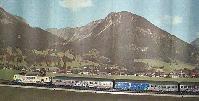
S
everal scenes showing the Märklin Idee+Spiel 'Graffiti train. It consists of a BR 111 engine and three passenger coaches. Each coach and the engine are painted with graffiti. The last coach has a control cab. The scene is the background used along the backwall for the center section of the layout.
O
ne of the best running engines on the layout is the (Märklin 3611) K.W.St.E. Beautiful Lady of Wurtemberg Class C locomotive. With its vintage passenger coaches it is also one of the most attractive trains on the layout. The engine runs so smoothly that it coasts to a stop. An engine well worth having. There are several pictures that show the train approaching the Calw station.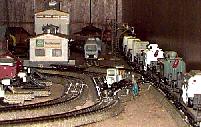
S
cenes showing track workers. The workers arrived at this site by railtruck just beyond the switch. A consist of depressed flat cars with transformers is seen on the right. In the background is a (Märklin 3776) double railcar that tilts as it rounds a curve waiting to be cleared.
![]() Revised:
Revised:
Views of the Pendolino (Märklin 3776) railbus. This rail bus tilts as it rounds curves. It is seen crossing the bridge, running along the river, stopping at Calw and rounding several curves.

![]() Revised:
Revised:
V
iews of the truck train pulled by a V220 (Märklin 37803) diesel engine which has diesel engine sounds and a horn sound. The train is seen as it passes the industrial section of the layout.
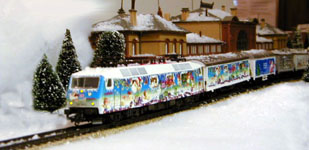
P
ictures of the Märklin (37531) BR 120 Christmas lok. The lok is seen pulling a consist of Christmas cars (Weihnachtswagens) from 1993 to 1998. The 1998 car is a tank car. The 1999 car is a flat car with Santa and a Christmas tree.Wir wünschen Ihnen ein schönes Weihnachtsfest
und ein gutes neues Jahr.